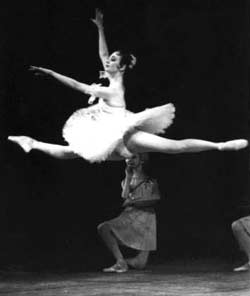Don Quixote
- Quick Facts:
- Composer: Ludwig Minkus
- Choreographer: Marius Petipa
- Author: Marius Petipa
- Premiere: December 14th, 1869, Bolshoi Theatre, Moscow

Prologue: Don Quixote, who is obsessed with stories of medieval chivalry, tells his servant Sancho Panza that he has decided to become a knight errant and improvises a suit of armor. Act I: In a marketplace in Barcelona Kitri is forced by her father, an innkeeper, to accept the offer of marriage of the rich Gamache and turn away Basil, the man she loves. Then Don Quixote arrives at the inn on Rosinante, his horse. He believes he recognizes in Kitri his "loved and idealized" lady Dulcinea. Act II: Don Quixote challenges Gamache to a duel but is mocked and chased away. Back in Barcelona Basil fakes suicide and asks Kitri's father with his "dying breath" for Kitri's hand in marriage. Thinking Basil is dying Kitri's father agrees, at which point Basil stops pretending to die and is happily united with Kitri. Meanwhile, out among the windmills, Don Quixote pays homage to the Gypsy King and joins in dances organized to mock him. Afterwards he attacks the marionettes of a traveling puppet show as if they were enemy soldiers, and taking the windmills to be hostile giants, charges at them. Act III: after being wounded in "combat," Don Quixote retires to the woods to rest, where he falls asleep with Sancho. While asleep, Don Quixote dreams that he is in Dulcinea's garden, which is inhabited by fantastic beings. While there he fights and conquers a giant spider and sees his lady. But then the dream fades away. Now, Don Quixote marches with the Duke and is invited to the Duke's castle. Act IV: At the castle festivities are held in Don Quixote's honour. He is challenged to a duel and horribly defeated by the "Knight of the Silver Moon" who is really just Don Quixote's old friend Carrasco, who makes Don Quixote promise to "sheathe his sword for at least a year." Don Quixote is disappointed but faithful to his word and returns home.
Although Petipa's creation was not the first ballet to be made from the Don Quixote story, it is by far the most successful and well remembered through several revivals. This is possibly because it was created at the height of Petipa's choreographic career. The grand pas de deux is often performed as a separate piece, but the version most often performed today is Anatole Oboukhov's revived version.